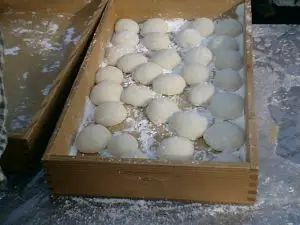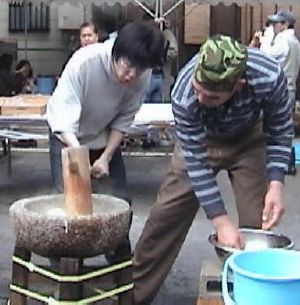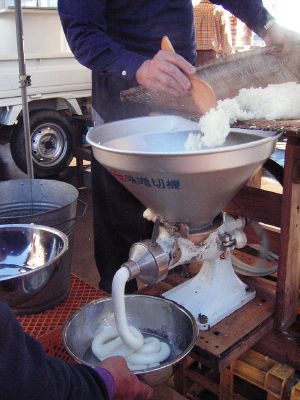Difference between revisions of "Mochi" - New World Encyclopedia
MaedaMartha (talk | contribs) |
MaedaMartha (talk | contribs) |
||
| Line 61: | Line 61: | ||
[[Category:Rice dishes]] | [[Category:Rice dishes]] | ||
| − | |||
| − | |||
| − | |||
| − | |||
| − | |||
| − | |||
| − | |||
| − | |||
| − | |||
| − | |||
| − | |||
| − | |||
| − | |||
| − | |||
| − | {{credits|Mochi|192.88.124.206}} | + | To make the rice cake "mochi" for 4 people, we need: |
| + | |||
| + | * 2 cups of brown rice | ||
| + | * 1 to 1.25 cups of water per cup of rice | ||
| + | * a pinch of seasalt per cup rice | ||
| + | |||
| + | Wash the rice and soak for a couple of hours or throughout the night. | ||
| + | Cook the rice in a pressure pan. Grind the cooked rice in a mortar, just as long as when the grain is completely fluid and sticky. This will take at least 30 minutes of griding when done by hand. Shape the mash into 2 centimeter squares. Put the rice squares onto an oiled plate and allow to dry for 1 to 2 days. Keep covered in a cold dry room or in the refrigerator. After this, roast the squares for 5 minutes in a pan. | ||
| + | |||
| + | [[Category:Japanese recipes|{{PAGENAME}}]] | ||
| + | [[Category:Recipes|{{PAGENAME}}]] | ||
| + | [[Category:Recipes_with_metric_units|{{PAGENAME}}]] | ||
| + | |||
| + | |||
| + | {{credits|Mochi|192.88.124.206|Cookbook:Mochi|72.187.101.114}} | ||
Revision as of 15:17, 7 May 2008
- For other uses, see Mochi (disambiguation).
Mochi (Japanese: 餅; Chinese: 麻糬) is a Japanese rice cake made of glutinous rice pounded into paste and molded into shape. In Japan it is traditionally made in a ceremony called mochitsuki. While also eaten year-round, mochi is a traditional food for the Japanese New Year and is commonly sold and eaten during that time.
Mochi is similar to the Chinese rice cake nian gao; however, mochi is shaped from cooked glutinous rice right after it is pounded, whereas nian gao is steamed directly to its final form from a batter made of uncooked glutinous rice flour. In the Philippines, it is called palitao in Tagalog and is coated with sesame seeds and grated coconut.
Mochitsuki
Mochitsuki is the traditional mochi-pounding ceremony in Japan.
- Polished glutinous rice is soaked overnight and cooked.
- The cooked rice is pounded with wooden mallets (kine) in a traditional mortar (usu). Two people will alternate the work, one pounding and the other turning and wetting the mochi. They must keep a steady rhythm or they may accidentally injure one another with the heavy kine.
- The sticky mass is then formed into various shapes (usually a sphere or cube).
Mochi may also be made in an automatic mochi machine, similar to a breadmaker. In fact, mochi can be made using a breadmaker if the rice is soaked and steamed separately and the machine can be started in a kneading mode.
Making mochi at home is possible without an automatic machine. Use a bamboo steamer or other apparatus that the sweets will not stick to while steaming. Add only enough water to allow the flour to stick together, form a small circle of the dough, then put a small amount of bean paste in the center. Close the dough over the paste and place in the steamer until the mochi congeals. Immediately upon removing the mochi from the steamer, coat the mochi in more sweet rice flour to prevent it from sticking to the hands of the maker.
Popular uses for mochi
Confectionery
Many types of traditional wagashi (Japanese traditional sweets) are made with mochi. For example, daifuku is a soft round mochi stuffed with sweet filling, such as sweetened red bean paste (an) or white bean paste (shiro an). Ichigo daifuku is a version containing a whole strawberry inside.
Kusa mochi is a green variety of mochi flavored with yomogi (mugwort). When daifuku is made with kusa mochi, it is called yomogi daifuku.
Ice cream
Small balls of ice cream are wrapped inside a mochi covering to make mochi ice cream. In Japan this is manufactured by the Korean conglomerate, Lotte under the name Yukimi Daifuku, "snow-viewing daifuku". In the United States the grocery chain Trader Joe's, H Mart, and Mollie Stone's sell mochi ice cream in flavors of chocolate, mango, green tea, coffee, vanilla, and strawberry. It is popular in California, Hawaii, Atlanta, Georgia and Portland, Oregon. A Japanese-owned company (Mikawaya) operating in Los Angeles makes Mochi Ice Cream, which is the variety that is sold by Trader Joe's and Mollie Stone's. Los Angeles and New York's Pinkberry yogurt also offers mochi as a "secret menu" topping on their desserts. It's not on the menu and kept in their fridges but if you ask for it they will get it for you.
Soup
- Oshiruko or ozenzai is a sweet azuki bean soup with pieces of mochi. In winter, Japanese people often eat it to warm themselves.
- Chikara udon (meaning "power udon") is a dish consisting of udon noodles in soup topped with toasted mochi.
New Year specialties
- Kagami mochi is a New Year decoration, which is traditionally broken and eaten in a ritual called Kagami biraki (mirror opening).
- Zōni soup is a soup containing rice cakes. Zoni is also eaten on New Year's Day. In addition to mochi, zoni contains vegetables like honeywort, carrot, and red and white colored boiled kamaboko.
- Kinako mochi is a mochi dish that is traditionally made on New Year's Day for luck. This style of mochi preparation includes roasting the mochi over a fire or stove, and then dipping it into a mixture of soy sauce, water and sugar, before finally briefly coating it in kinako (soy flour).
Other
- Dango is a Japanese dumpling made from mochiko (rice flour).
- Warabimochi is not true mochi, but a jelly-like confection made from bracken starch and covered or dipped in kinako (sweet toasted soybean flour). It is popular in the summertime, and often sold from trucks, not unlike ice cream trucks in Western countries.
- More recently, "Moffles" (a waffle like machine used to cook Mochi's) has been introduced with much fanfare. Ref: http://search.japantimes.co.jp/cgi-bin/nn20080319f1.html
Notes
See also
- Tangyuan
- Chè xôi nước
To make the rice cake "mochi" for 4 people, we need:
- 2 cups of brown rice
- 1 to 1.25 cups of water per cup of rice
- a pinch of seasalt per cup rice
Wash the rice and soak for a couple of hours or throughout the night. Cook the rice in a pressure pan. Grind the cooked rice in a mortar, just as long as when the grain is completely fluid and sticky. This will take at least 30 minutes of griding when done by hand. Shape the mash into 2 centimeter squares. Put the rice squares onto an oiled plate and allow to dry for 1 to 2 days. Keep covered in a cold dry room or in the refrigerator. After this, roast the squares for 5 minutes in a pan.
Credits
New World Encyclopedia writers and editors rewrote and completed the Wikipedia article in accordance with New World Encyclopedia standards. This article abides by terms of the Creative Commons CC-by-sa 3.0 License (CC-by-sa), which may be used and disseminated with proper attribution. Credit is due under the terms of this license that can reference both the New World Encyclopedia contributors and the selfless volunteer contributors of the Wikimedia Foundation. To cite this article click here for a list of acceptable citing formats.The history of earlier contributions by wikipedians is accessible to researchers here:
The history of this article since it was imported to New World Encyclopedia:
Note: Some restrictions may apply to use of individual images which are separately licensed.




